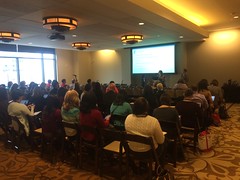
Speakers: Jaclyn Bedoya & Michael DeMars, CSU Fullerton
There are some challenges to surveying students, including privacy, IRB requirements, and survey fatigue. Don’t collect data for the sake of collecting data. Make sure it is asking what you think it is asking to get results that are worth measuring.
Google Analytics is free, relatively easy to use, and easy to install. And it’s free. We’re being asked to assess, but not being given a budget to do so.
It’s really good about measuring the when and where, but not the why. Is it that you don’t see Chrome users because nobody is using Chrome, or is it that your website is broken for Chrome users?
If people are hanging out on your library pages for too long, then maybe you need to redesign them. We want them heading out quickly to the resources we’re linking to.
They’ve made decisions about whether to spend time on making sites compatible with browser versions based on how much traffic is coming from them. They’ve determined that mobile use is increasing, so they are desigining for that now.
They were able to use click data to eliminate low-used webpages and tools in the redesign. They were able to use traffic data to determine how much server support was needed on the weekends.
Google Forms are free and they can be used to find out things about users that Analytics can’t tell you. They can be embedded into things like LibGuides. There’s a “view summary responses” option that creates pie charts and fancy things for your boss.
They asked who they are (discipline), how often they use the library, where they use it, and what they thought of the library services. There were incentives with gift cards (including ones for In-N-Out Burger). The free-text section had a lot of great content.
The speakers spent some time on the survey data, but the sum total is that it matched their expectations, but now they had data to prove it.


